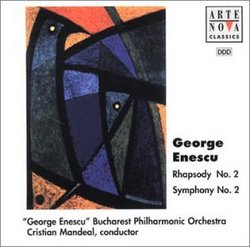| All Artists: Enescu, Mandeal Title: Rhapsody 2 / Symphony 2 Members Wishing: 0 Total Copies: 0 Label: Arte Nova Records Release Date: 1/1/1998 Genre: Classical Styles: Historical Periods, Modern, 20th, & 21st Century, Symphonies Number of Discs: 1 SwapaCD Credits: 1 UPC: 743213403526 |
Search - Enescu, Mandeal :: Rhapsody 2 / Symphony 2
 | Enescu, Mandeal Rhapsody 2 / Symphony 2 Genre: Classical
|
Larger Image |
CD Details |
CD ReviewsLike Strauss (Richard) In Bucharest Thomas F. Bertonneau | Oswego, NY United States | 08/05/2001 (4 out of 5 stars) "A colossal talent like that of Bela Bartok (for example) could not remain confined within its native bounds so that the composer quickly became a European rather than a merely Hungarian phenomenon. The same is true of Bartok's contemporary, George Enescu (1881-1955), a Rumanian by birth who spent much of his creative life, after his youth and education, in Paris. Enescu enjoys less currency today than Bartok but he was a creative artist of nearly the same stature whose music, like Bartok's, stemmed from the folk-ethos of his native soil and yet also boasted tendencies that critics would label (with reason) as "modernist." Enescu, like Bartok, presented himself initially as an instrumentalist - he was a string-player of renown - only later to emphasize the change of roles. Due to causes difficult to specify, however, his music lapsed into almost total oblivion in the second half of the twentieth century. The only exceptions were his two Rumanian Rhapsodies, which persisted as items in the summer "pops" repertory. Where Bartok concentrated on the concerto, Enescu concentrated on the symphony, commencing six or seven of them and completing four. The four are the numbered symphonies, One through Three (1902, 1916-17, and 1919-21), and the Sinfonia da Camera (1955), for ten instruments. Cesar Franck supplies the obvious model for Symphony No. 1 (E-Flat). For Symphonies Nos. 2 (A-Major) and 3 (C-Major), both much larger in scale than No. 1, the benchmarks for comparison might be Richard Strauss and Alexander Scriabin. These works require enormous orchestras, with No. 3 adding a wordless chorus and an organ in the Finale; Enescu works, like Strauss in the "Alpine Symphony" and Scriabin in "The Divine Poem," on a large scale. On the other hand, despite their hyperbolic character, both No. 2 and No. 3 feel more "symphonic" than the scores of Strauss and Scriabin. Arte Nova offers a complete cycle of Enescu's symphonies at their super-budget price of around five dollars a disc. The conductor, Cristian Mandeal, leads the George Enescu Bucharest Philharmonic in recordings made in the early 1990s. Symphony No. 2 caused its composer some problems: It uses the largest orchestra that Enescu had yet specified, exhibits a profusion of themes in all three movements, and is harmonically audacious. After its first few performances, Enescu withdrew it, tinkering with it for the rest of his life without reissuing it. Where works like the Rhapsodies and the Third Suite for Orchestra mine Wallachian and Transylvanian folklore, the symphonies adhere to a more "international" language. Symphony No. 2 begins (Vivace, Ma Non Troppo) with a tempestuous opening paragraph related, one guesses, to the war. (Romania fought with Britain, Russia, and France against Austria and Germany.) A slower second subject does exhibit Romanian inflection; its treatment grows impassioned. The violin rises up in a lyrical solo; so at one point does the horn. In Mandeal's performance, the First and Third Movements both clock in at 19.01. The central Second Movement, in slower tempo (Andante), is shorter, running to 13.28. It relaxes from the drama of the foregoing Vivace and features beguiling, singable wind-solos. The troubled Finale (Un Poco Lento, Marziale - Allegro Vivace) adds piano and a huge percussion battery to the already outsized orchestra. Mandeal's competition comes in plural from an older Marco Polo CD, from an Olympia CD of similar vintage, and from Gennady Rozhedestvensky's 1997 reading with the BBC Philharmonic on Chandos. The Marco Polo entry is out of the running (boxy sound, not much rigor in the intrepretation), while the Olympia entry is probably difficult to find. Chando's CD impresses mightily, but then so does Arte Nova's. Given the difference in price, the budget-label appears a clear winner. Recommended."
|

 Track Listings (4) - Disc #1
Track Listings (4) - Disc #1